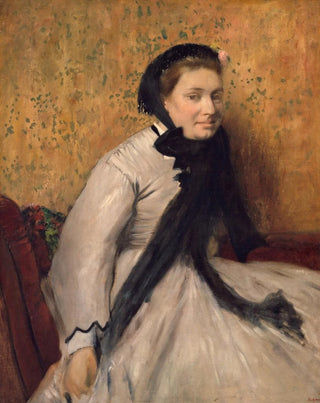Art print | Portrait of a woman in gray - Edgar Degas


View from behind

Frame (optional)
The "Portrait of a Woman in Gray" by Edgar Degas is a work that embodies the finesse and subtlety of modern portraiture. Created at the end of the 19th century, this painting reveals a woman whose mysterious aura and elegant posture immediately captivate the viewer. The gray palette, both soft and deep, evokes an intimate, almost melancholic atmosphere, where each nuance seems to tell a story. The depiction of the female figure, often at the heart of Degas's artistic concerns, engages in a dialogue between light and shadow, thus revealing the complexity of human emotions. This piece, both delicate and powerful, invites the viewer to immerse themselves in a universe where aesthetics meet psychology.
Style and uniqueness of the work
Degas's style is distinguished by an innovative approach to movement and composition. In the "Portrait of a Woman in Gray," the artist employs pastel techniques that allow him to explore varied textures and subtle plays of light. The woman, dressed in a gray dress, is presented in a posture that is both natural and contemplative, giving her an almost timeless dimension. The features of her face, though sketched, are imbued with an intensity that suggests psychological depth. Degas, true to his habit, does not merely reproduce reality; he transcends it, capturing the very essence of his subject. This work stands out for its ability to evoke universal feelings while maintaining a singularity that is unique to it.
The artist and his influence
Edgar Degas, an emblematic figure of the Impressionist movement, managed to mark his era with a unique vision of art. Although often associated with ballet scenes and Parisian life, his portraits, such as "Portrait of a Woman in Gray," reveal another facet of his talent. His influence on modern art is undeniable, as he paved the way for generations of artists by exploring themes such as the human condition, movement, and intimacy. Degas also played with daring angles, inviting the viewer to position themselves differently.

Matte finish

View from behind

Frame (optional)
The "Portrait of a Woman in Gray" by Edgar Degas is a work that embodies the finesse and subtlety of modern portraiture. Created at the end of the 19th century, this painting reveals a woman whose mysterious aura and elegant posture immediately captivate the viewer. The gray palette, both soft and deep, evokes an intimate, almost melancholic atmosphere, where each nuance seems to tell a story. The depiction of the female figure, often at the heart of Degas's artistic concerns, engages in a dialogue between light and shadow, thus revealing the complexity of human emotions. This piece, both delicate and powerful, invites the viewer to immerse themselves in a universe where aesthetics meet psychology.
Style and uniqueness of the work
Degas's style is distinguished by an innovative approach to movement and composition. In the "Portrait of a Woman in Gray," the artist employs pastel techniques that allow him to explore varied textures and subtle plays of light. The woman, dressed in a gray dress, is presented in a posture that is both natural and contemplative, giving her an almost timeless dimension. The features of her face, though sketched, are imbued with an intensity that suggests psychological depth. Degas, true to his habit, does not merely reproduce reality; he transcends it, capturing the very essence of his subject. This work stands out for its ability to evoke universal feelings while maintaining a singularity that is unique to it.
The artist and his influence
Edgar Degas, an emblematic figure of the Impressionist movement, managed to mark his era with a unique vision of art. Although often associated with ballet scenes and Parisian life, his portraits, such as "Portrait of a Woman in Gray," reveal another facet of his talent. His influence on modern art is undeniable, as he paved the way for generations of artists by exploring themes such as the human condition, movement, and intimacy. Degas also played with daring angles, inviting the viewer to position themselves differently.






